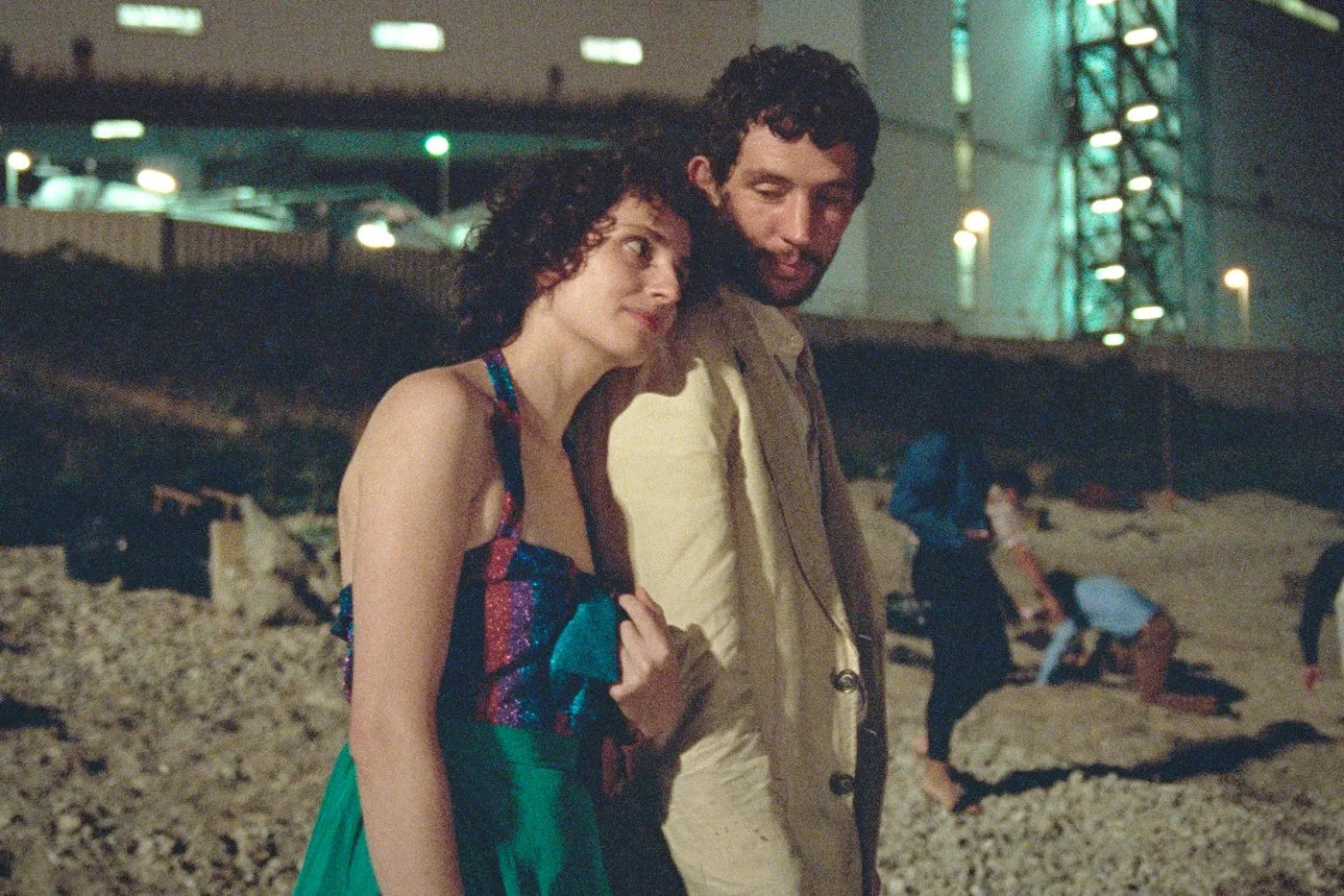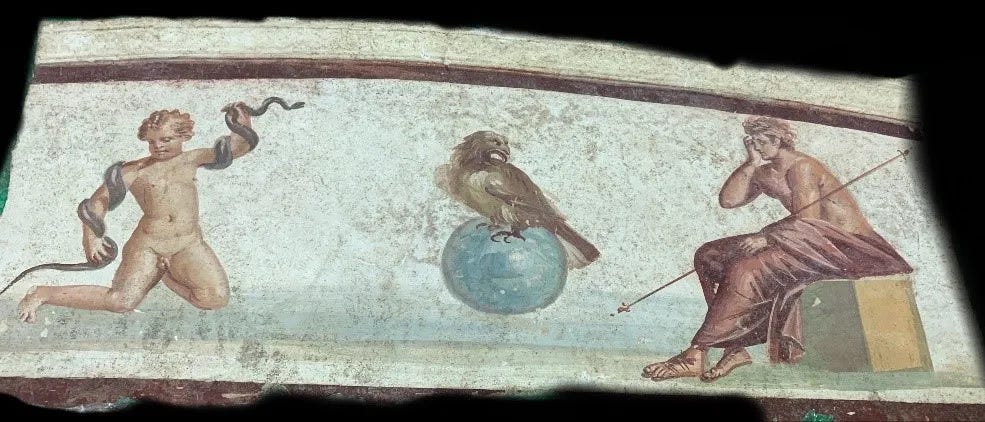Ercolano, "La Chimera," and American Grave Robbers
notes from the 1980s archaeologist of the city of Herculaneum, Alice Rohrwacher's stunning movie, and treading on the dead
Recently I had the great pleasure of getting to visit Pompei and Ercolano down in Campania, outside of Napoli. Pompei, of course, is wildly famous, but what I didn’t know was that there is, in fact, from the same disastrous volcanic eruption of Vesuvius in 79 AD, many other sites preserved that don’t just include the enormous commercial city of Pompei.
As such, Ercolano (or Herculaneum in English), was pretty much unknown to me, whereas I’d been reading about Pompei since I was a kid, with imagined versions of it living in my mind. Ercolano is a second full city completely preserved—the experts say in even better condition—than Pompei, although it was a quieter town, one on the seaside where Romans were living peaceably but without major temples, markets, or as much infrastructure as in grand Pompei.
Walking Ercolano is surreal. Its urban structure is dense, packed with ancient houses both humble and well-to-do, full of preserved frescoes, furniture, full mosaic floors, even calcified wood, so you can see how roofs and shelves were built exactly during the time. Plus, the ancient site is physically attached to the modern town, which is a strange experience. There’s a theater, for example, found in the middle of the town almost 200 years ago, set above the center of the ancient city higher up on the hill, and as a result you actually have to enter the ancient theater from Main Street of the modern town. But the main part of the old city is set further down, on what was the ancient shoreline, radically altered by a city-high, cataclysmic flood of mud, caused by the volcano some 2000 years ago.
After our visit to the city, I picked up a little book in the gift shop translated into English. I wanted to get more background on this lesser-known ancient city. I did not in fact get all of the background on the city I was hoping for, but instead I got a first-hand account from the key archaeologist in the ’80s who discovered that there was an ancient shoreline—his name is Giuseppe Maggi. The discoveries that this fellow made with his team were really radical, essentially changing all of the theories about what happened to the residents of this town during the volcanic disaster.
What actually stayed with me from Maggi’s little book, though, is not the details of his extraordinary discoveries—those are amazing—but actually his narrative comments on the side of the main drama. It’s often the case that people reveal themselves in asides when they’re supposed to be sticking to the main plot. In this little book “Herculaneum: End of an Ancient Town,” you get a lot of detail from Maggi about what it was like to interact with the Americans, from whom the Italian scholars and workers involved were pretty ferociously trying to get funding in order to complete all this work at Ercolano. I felt a sense of embarrassment at how an extraordinary discovery of a complete skeleton of a soldier was found intact—my guy was roughly 6’ 2”, a crazy size for the ancient world, and found with his swords, leather scabbard, and more, by the beach—and they preserved him and carted him all the way to New York to show him to extremely wealthy donors belonging to the National Geographic Society, hoping to secure ongoing private resources to make the full excavation continue. Things like this make me hate being from the U.S. – knowing that great wonders of the world have to be dragged from their homelands and paraded in front of a bunch of bingbongs who have their American inherited money through, almost always, extremely unsavory origins.
But also, Maggi is really pissy in his book about an American scientist when she was called in to help his team in the ’80s —I wondered if he was pissy because of her methods, as he claims; pissy because she was American and fairly direct in her demeanor; or pissy because she was a woman and basically telling him what to do: in order to both preserve the dramatic dozens of preserved human corpses they had found at that point, as well as to analyze their remains. Check out these two passages:
“Sara Bisel arrived at the end of June with three assistants, and bluntly informed me that there was no alternative to taking apart the bodies. The bones needed to be put in a special solution to be fully solidified and then could be reassembled using special adhesive agents. The analysis of the remains (and those that were still to be discovered) would be of immense scientific importance, establishing with precision the gender, age, state of health, nutrition, acquired and genetic conditions, and hereditary traits of each victim. It would be possible to obtain a realistic picture of the ancient eco-system. I asked whether there was a way to combine the method with others that could keep the emotion of the discovery alive and be more sensitive to the victims’ remains, but Bisel’s answer was that alternatives could risk turning the whole lot to dust.
Sometimes Bisel's attitude was harsh, especially as I expressed scepticism over the possibility - following her method - of restoring the pathos of the discovery by putting the reassembled bodies back in the places they were found, even though the whole operation would be meticulously documented with photographs and written records. I could not forget the impression made on me by reconstructions of some native American villages in a noted natural history museum in the USA, with models dressed in garish garments and adorned with colourful feathers. I was even more horrified by the wax models at Madame Tussauds. But Sara had no doubts that the macabre re-composition of the bodies, draped like ancient Romans, would be a compelling spectacle.”
He's not wrong about our horrible natural history museum “people” displays. They are wretched and should be taken down. But then there’s another one, Maggi quoting himself from a piece of press around that time period, regarding the overall discovery of what happened to all the victims of the cataclysm at Ercolano:
“This tragedy, which we had sensed, nevertheless caught us unprepared. Evidence this dramatic is akin to works of art that one would wish to capture unchanged, before the force of the elements dissolves them like figures made of sand. But our search for solutions to preserve every attitude and gesture at the moment of discovery has not yet been satisfactory. The intervention of the American experts who dismember bodies for investigation is in some way exorcising that tragedy. However, as an archaeologist I am tormented by such a solution. Once a body is dismembered, the pathos vanishes. It risks making the authentic impression of a tragedy the heart-aching privilege of the excavator.”
American experts who dismember bodies for investigation! Dismember feels like a really judgey word to use. Elsewhere, in his distress, Maggi wonders regarding this Sara Bisel if archaeologists are any better than grave robbers, if these are the methods they’re going to use to make their discoveries and do their research.
All of this makes me think of a scene or two from a movie I haven’t been able to get out of my head since I saw it twice over the last year, Alice Rohrwacher’s La Chimera. It’s also set in the 1980s in Italy, following a bedragged, tall, British archaeologist who has fallen in with a company of Italian puckish grave robbers, not least because he is an expert on the ancient world, but also because he has strange visions when he is near hidden sites of buried wonders. It is a dazzling and achey movie, full of the simultaneous decay and glory of Italy in the current age, the depth and magic of the ancient world hidden right beneath her.
Josh O’Connor is a pleasure to watch as the mumbling, softly heartbroken archaeologist, a stranger in this sunlit and crumbling world. But even better is Carol Duarte as the character Italia, a gangly, charming metaphor of a character for the entire country—incapable of singing, secretly raising children, with a wide gap-toothed smile.
There’s a scene where Italia, after becoming close with archaeologist Arthur and his motley crew, realizes that they’re all grave robbers, when they all stumble across a special site at a beach together. Her horror is touching: she wants to go find the police immediately, she kisses a cross around her neck (twice), she stumbles away from the company in flight from their sacrilege. Rohrwacher’s movie rotates a lot around the idea of thieves and commerce equally having no dignity; the way people will ransack or destroy what is imbued with spirit in order to make some coin. But it’s also just really sweet the way that the naïve Italia can’t seem to wrap her head around it: these people seemed decent, and they’re really ok with robbing tombs? With stomping around the dead?
This character, placed alongside archaeologist Giuseppe Maggi’s disdainful accounts of his American compatriot—who is not a grave robber but “dismembers” human remains—gives me something of an insight on the spirit of this country. It’s not superstition; that would be oversimplifying it. Instead it’s something like a vague sense of the sanctity of the ancient world living hand-in-hand with people who live and walk by history so often here, they pay it no mind at all. Majesties crumble, funding is hard to find, regular people need money, who gives a shit about the ancient theater right on your main street?
But also: leave the dead, don’t take their treasures, and please don’t ship our soldier to New York and cover him with wax and make him awful.
I don’t know which character in La Chimera I relate to more: the foreign Arthur, who with his strange giftedness and longing tries to bridge the gap between the living and the dead? Or Italia, who lives so thoroughly in the present, blithely unaware of her ancient home, who is beautiful in her vividness: she brightens up dilapidated rooms, plays with children, dances at parties, burns the laundry ironing. Ultimately Italia is better-adjusted, it seems, but Arthur is touched by the sun, in a half-beautiful, half-tragic way.
I wonder what Sara Bisel would make of the Italian criticism of her efforts at Ercolano, to flesh out the research on who its citizens were and how they lived. I, too, often find my fellow Americans lack any sense of spirit or mystery, and I have seen us ransack and destroy the ancient world—if there’s oil or diamonds or bananas to be funneled home, riches to exploit and hoard. But the archaeologist Maggi is awfully temperamental, too… Sanctimoniousness doesn’t exactly reveal the ancient world back to us, either.
It is magical to get to visit sites of the ancient world, uncovered by massive efforts of technicians and scholars, and yes, aristocrats. But maybe we should leave the rings on the fingers of the dead when we can, or the coins over their eyes. Even thousands of years later, there’s probably some potency in those objects and actions still. Or at least we can make sure they don’t get stolen by Bourbon princes, sold off on a black market for secret buyers, or dragged off to a foreign shore to preside over a luncheon in Manhattan.









